Funny Round Green Porcelain Rooster Figurines Made in China
Welcome Join our Antique Chinese and Japanese Porcelain Collectors Discussion Board
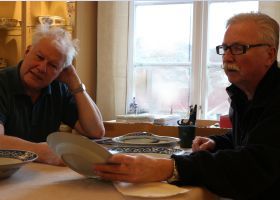 Post your own pieces and let hundreds of other experts and collectors world wide take a look in a private and protected environment. Unlimited number of posts, no spam, no advertising, no Google indexing, no tracking, no selling of personal data. Or search our massive archive of more than 360,000 old posts, comments and pictures of antique Japanese and Chinese porcelain. Our archive has taken more than twenty years to build and let you research almost anything in Asian ceramic art. Specialists or beginners are equally welcome to join. Contribute $9.95 USD per month or only $29 USD for a full year of full access. Ok, let me in! or read on:
Post your own pieces and let hundreds of other experts and collectors world wide take a look in a private and protected environment. Unlimited number of posts, no spam, no advertising, no Google indexing, no tracking, no selling of personal data. Or search our massive archive of more than 360,000 old posts, comments and pictures of antique Japanese and Chinese porcelain. Our archive has taken more than twenty years to build and let you research almost anything in Asian ceramic art. Specialists or beginners are equally welcome to join. Contribute $9.95 USD per month or only $29 USD for a full year of full access. Ok, let me in! or read on:
Look for your favorite topics here.
The purpose of our Antique Chinese and Japanese Porcelain Collectors Discussion Board is to help, have fun and to pass on decades of practical knowledge on how to tell genuine Asian antique ceramics from fakes. This is really serious since the material knowledge is more complicated than plain Arts History. The material knowledge addresses the actual authenticity of specific items and not only if they are "in the style of". We do this by encouraging hundreds of experienced collectors to clap together our various expert knowledge and thus forming a formidable knowledge resource, while at the same time having fun, learning, and adding value to our own collections.
Specialists or beginners are equally welcome to join. Experienced dealers who are aware of the commercial limitations are particularly welcome to share your knowledge. Who knows, there might be bits and pieces for you too to pick up.
Sign Up Visit Discussion Board
The Swedish exhibition of Chinese pottery and porcelain in the 'Forbidden City' (Gugong), Beijing 2005
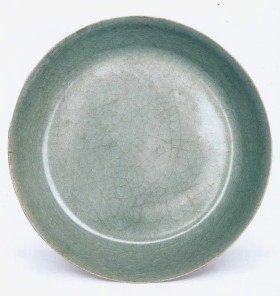
During September to December 2005 a Swedish sponsored exhibition of Chinese pottery and porcelain was held at the Wumen Exhibition Hall in the Forbidden City (The Gugong, or Old Palace Museum) in Beijing.
The exhibition highlighted the long history of peaceful relations and exchange between Sweden and China, from J G Andersson discovering the Chinas Neolithic past to The East Indiaman Gotheborg ship excavation, rebuilding and new China voyage.
The exhibition focus on the excavation of the East Indiaman Gotheborg and Chinese Armorial porcelain and special porcelain made to order of the Swedish East India Company but also highlight Neolithic pottery and extremely rare Imperial wares such as Ru ware in the Swedish Röhss Museum Collection. Welcome to browse the on-line version of the catalog here.
The Tang 'Belitung' or Batu Hitam) shipwreck of ca 830, exhibition in Singapore 2016
The Belitung (Tang or Batu Hitam) shipwreck sank on its way back from China around 830 AD. The ship contained untold treasures of gold and silver and the first Chinese underglaze blue and white dish known to mankind.
A large proportion of the most important finds were exhibited at the Asian Civilisation's Museum in Singapore, in 2016.
A study expedition to Jingdezhen with Professor Bo Gyllensvärd, in 1992

Only a few yards from this spot at the river banks of the Chang River, flowing through the city of Jingdezhen, the Chinese Imperial kiln was built during the Yuan dynasty. During 700 years this factory produced the best porcelain in the world and became the porcelain factory of the entire world well into the 18th century.
During the centuries all kinds of Chinese porcelain shards and kiln debris has been dumped and discarded as the city grew. So much in fact that the city of Jingdezhen are now said to rest on a thick layer of porcelain shards, 30 feet deep or more in places, we were told.
In 1992 I was invited to take part in a study expedition to visit the excavations of the former Imperial Porcelain Kiln, together with Professor Bo Gyllensvärd and two friends. Here is my diary and some of the results and photos from the visit.
Click here to visit my report from Visit to Jingdezhen 1992
Text & Photo © Jan-Erik Nilsson.
A Visit to the old Nanfeng kiln in Shiwan, Fushan city near Guangzhou (Canton), 2006
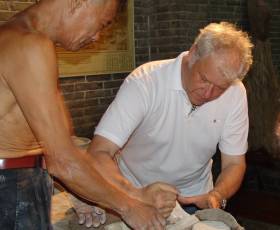
During 2006 I had the pleasure to, together with the Gotheborg III Ship project friends and co-founders Anders and Berit Wästfelt, visit Guangzhou and also take the opportunity to visit the not much visited but very important city of Fushan and the Nanfeng kilns in Shiwan. The staple town for tea and porcelain enamels during the 18th century.
This is the origin of the old Kwangtung wares and the heavily glazed tiles, pots and masterly sculpted figures. Well known from late Ming, popular during Qing and very much alive until today.
Welcome to visit Shiwan with me.
The East Indiaman Gotheborg III Ship, in Guangzhou, 2006
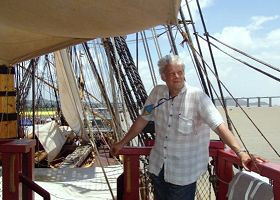
The 17th of July 2006 the rebuilt replica of the first 'East Indiaman Götheborg' arrived at Boca Tigris in the Pearl River delta outside Canton, to later move up to the old anchorage at 'Whampoa', to come to rest opposite the White Swan Hotel in the center of today's Guangzhou (Canton).
During the last part of the trip HRH the King and Queen of Sweden joined the crew on-board. 
The entire project of recreating an 18th century Swedish East Indiaman and sending her to China again and back was all started as a private project by a small group of enthusiastic professionals, based on the excavation of the original East Indiaman Gotheborg.
Since I was one of them, here is my story on the [ PROJECT ] and the [ ARRIVAL IN GUANGZHOU ].
Jan-Erik Nilsson
Walking the streets of old Canton. Visit to Guangzhou in 2006
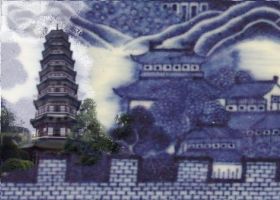
In July 2006 the rebuilt Swedish East Indiaman 'Gotheborg' Ship finally arrived in Guangzhou, China, or Canton as it was known as during the time of the Swedish East India trade.
Since I had been involved in the starting of the project to build and sail a full scale replica of the East Indiaman Götheborg to China, I also really wanted to explore the City of Canton to see what was left from the early days of the China trade, when we eventually arrived. To my help to use as a map, I had a rare Chinese export porcelain dish - with its main motif, a painting of the old City of Canton ...
The dish in itself is from the end of the 18th century but portrays the inner part of the city, behind the European factories located at the river side.
The exact source for this painting still remain to be found, but in the collection of the China Castle in Stockholm, Sweden, dating to the 1740s there is an album leaf which shows a high degree of similarities. [ more ]
Malacca - the historic port of exchange of old West and Inter Asian trade
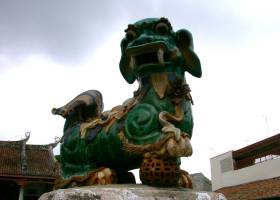
In May 2002 I mentioned to some friends in Singapore, that I was planning to visit Southeast Asia again to among other things visit the very important historic trade city of Malacca on the west coast of Malaysia,
The pace of life in Singapore is fast and one hour later I got a call back. Everything was arranged. They would take the day off and if I could sleep for four hours after arrival in Singapore we would leave for Malacca by car at 4 am in the morning, so we would lose the morning traffic and have better driving temperature and that it would only take some three hours of driving anyway ...
So, I arrived after some 20 hours of air flight from Sweden via Amsterdam. A few hours later I was whisked off to Malaysia - still fast asleep - to wake up to breakfast and Kopi-O (black coffee without milk) just a few hundred meters from where a beautiful Ming princess and her tourage was set ashore to marry the Sultan of Malacca some 500 years earlier. Which was one of the reasons why I wanted to see this place ...
Click here to follow me to Malacca, Malaysia, in May 2002.
Text & Photo © Jan-Erik Nilsson.
Visit to old Terracotta Pottery Kiln in Bali, 2012
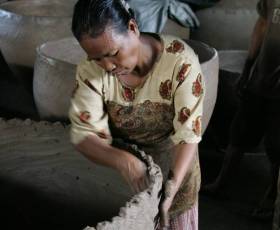
A while ago I visited Bali in an attempt to look for traces of the old Majapahit Kingdom.
While the historic center of the Majapahit Kingdom had been located at the eastern end of the just nearby Java Island, Bali was to me of equal interest. Somewhat I also hoped that more of the old culture would had remained through the Buddhist and Hindu traditions, still predominant in Bali since much of the actual downfall of the Majapahit had been contemporary with Islam becoming the dominating belief on Java.
What I found was a beautiful Island, fairly modern and very friendly, and a local Terracotta Pottery and Kiln, still very much functioning, putting out large terracotta Jardinières for flowers and garden decorations. In was interesting to see how these large pots were made from the mud up to finished lead glazed pots, taller than men.
Visit Bali with me.
Visit to Singapore and Hong Kong, March 2001

During March 3-12, 2001 I had the pleasure of visiting Singapore and Hong Kong. The purpose of the visit was to deepen my understanding of the Straits Chinese Porcelain and the related culture.
I also wanted to study 19th and 20th century Chinese porcelain, products of less known "provincial" trade porcelain kilns in Southern China, and to get a first hand impression on the trade in antique Chinese porcelain fakes, to visit several important scholars and collectors in the area, to learn and to take part of their specific knowledge.
Here is a short travel report to summarize some of my thoughts.
Click here to read the report from my Visit to Singapore and Hong Kong, March 2001
Text & Photo © Jan-Erik Nilsson.
Visit to Sten Sjöstrand off Tioman Island Malaysia, Sept. 2001

In September 2001 I got an invitation to visit the base camp of Sten Sjöstrand's marine archaeological and salvage expedition in Malaysia. I did and I am back. After a much needed shower and some rest I put together the following report.
I got to see piles of Si-Satchanalai (Sawankhalok district, Sukhothai) pieces, still in storage from the excavation of the Royal Nanhai 16th century cargo of Celadon ceramics - plus the very reason of my visit - a surface sample collection from the recently discovered 19th century and possibly "Straits Chinese" cargo. Now that can't be said to have been the case, but it was interesting anyway.
An underwater visit to the Desaru wreck site, Malaysia 2000
Click here to read my letter to the friends on the Gotheborg Forum after my Visit to Sten Sjöstrand off Tioman Island, Malaysia, Sept. 2001
Text & Photo © Jan-Erik Nilsson.
Frank B. Lentz visit to Jingdezhen November 1920

In November 1920, immediately after that the Chinese Empire had fallen and the Imperial Porcelain Factory had been turned into a private venture, Frank B. Lenz visited Jingdezhen.
His report was published together with photos by the author, in the November 1920 issue of The National Geographic Magazine.
This entire article is available here.
"Twenty Illustrations of the Manufacture of Porcelain", by Tang Ying in 1743, Full text and modern photo illustrations.

This is one of the most important original documents on the manufacturing of porcelain ever written. Tang Ying was the most famous of all superintendents of the Imperial Porcelain factory in Jingdezhen, active during 1736-1753.
The translation was made by S. W. Bushell in 1899. Since the original pictures from 1743 are lost, I have illustrated the text with pictures - where applicable - taken by me, in 1991 and 1992, when I had the privilege of spending a few weeks in Jingdezhen together with Professor Bo Gyllensvärd where I could study the porcelain potteries as they were still running.
Letters of Père d'Entrecolles 1712 and 1722
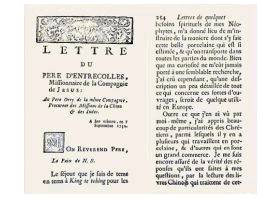
The Letters of Père d'Entrecolles (1664-1741) here for the first time translated, commented and available in full on-line.
Being a French Jesuit missionary while spending some time in Jingdezhen Father d'Entrecolles got to know the porcelain industry of the early 18th century well. His reports was sent to and published in Europe in 1712 and 1722.
These two Letters of Pere d'Entrecolle are the most important accounts we have on the Chinese porcelain manufacturing in the early Qing dynasty and is important to understand for the authentication of antique porcelain.
Q&A Porcelain Info Section with pictures of Chinese and Japanese porcelains, popular styles, shapes and decorations. This is a sample selection of our replies to our visitors emailed questions. These plus our Dictionary and porcelain Marks section are all searchable via the Search box. Please see Ask a Question on how to submit your own questions. For collectors of antique Chinese and Japanese ceramics wanting a community of friends to talk to, welcome to join our Forum.
HOME | ASK | FORUM | MEMBERSHIP
| MARKS | SEARCH | GLOSSARY | CHRONOLOGY | SHIP | BOOKS | FOR SALE
The sole purpose of all information found on gotheborg.com list or web page are for entertainment or educational purposes only. All expressed opinions are my personal, based on photos and the owners submitted descriptions, and are not to be used for any financial or commercial decisions but for educational and personal interest only. By accessing the information offered at the gotheborg.com list or web page you expressly agree that any use of the gotheborg.com list or web page is at your own risk. Gotheborg.com expressly disclaim all warranties of any kind. Nor does gotheborg.com make any warranty as to the results that may be obtained from the use of Gotheborg.com or as to the accuracy or reliability of any information obtained through the Gotheborg.com Forum or web page. Any user must evaluate and bear the risk associated with the accuracy or lack thereof of any content published on the gotheborg.com list or web page. You also agree that you will not upload or transmit any content to the gotheborg.com list or web page that infringes any copyright or other proprietary rights of any party. By submitting content in any form you automatically grant or warrant that the owner of the content has expressly granted gotheborg.com the royalty-free right and license to use, reproduce, modify, adapt, publish, translate, create derivative works from, distribute and display such content in whole or part worldwide and/or to incorporate it in other works in any form, media, or technology now known or later developed for the full term of any rights that may exist in such content. Gotheborg.com is not responsible for any messages or their attachments intentionally or unintentionally violating any applicable local, state, national or international law, including but not limited to any regulations having the force of law. ALL CONTENTS ON THIS SITE ARE PROTECTED BY COPYRIGHT AND, WHERE APPLICABLE, OTHER INTELLECTUAL PROPERTY RIGHTS. NO PORTION OF THE INFORMATION ON THIS SITE MAY BE REPRODUCED MODIFIED, PUBLISHED, UPLOADED, POSTED, TRANSMITTED, OR DISTRIBUTED IN ANY FORM, OR BY ANY MEANS, WITHOUT PRIOR WRITTEN PERMISSION FROM GOTHEBORG.COM, AND NOTHING CONTAINED HEREIN SHALL BE CONSTRUED AS CONFERRING BY IMPLICATION, ESTOPPEL OR OTHERWISE ANY RIGHT UNDER ANY TRADEMARK OR COPYRIGHT OF GOTHEBORG.COM OR ANY THIRD PARTY.
This internet site begun the 26th of November 1996 under the by Jan-Erik Nilsson registered domain gotheborg3.se. Design and content of all pages as they appear on gotheborg.com © Jan-Erik Nilsson, Gothenburg, Sweden 1993-2014. It has remained online since December 3, 1998, first edition 26th of November 1996 under gotheborg3.se to the benefit of the Internet community at large.
Source: https://gotheborg.com/
0 Response to "Funny Round Green Porcelain Rooster Figurines Made in China"
Enregistrer un commentaire